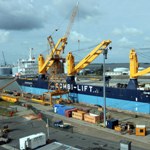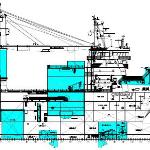Combi Dock IV To Become OIG Giant II
 Lloyd Werft is to convert Harren’s Combi Dock IV into an offshore support vessel. It is only nineteen months since the Combi Dock IV left Lloyd Werft. Due back in Bremerhaven in August, the 162.3m Combi Dock IV will be converted for the OIG Offshore Installation Group – newly created by Harren & Partners – into the OIG Giant II. She will enter service in her offshore support vessel role at the end of September.
Lloyd Werft is to convert Harren’s Combi Dock IV into an offshore support vessel. It is only nineteen months since the Combi Dock IV left Lloyd Werft. Due back in Bremerhaven in August, the 162.3m Combi Dock IV will be converted for the OIG Offshore Installation Group – newly created by Harren & Partners – into the OIG Giant II. She will enter service in her offshore support vessel role at the end of September.
“It’s not just the tight deadline that is a challenge for Lloyd Werft”, said yard managing director Rüdiger Pallentin. He is also delighted that the Bremen shipping group again placed its trust in the shipyard and has given it yet another opportunity to prove its global reputation as a leading builder of specialised ships. “It’s a first-rate job and a sporting challenge in such a short time-frame, but we are used to that here.”
Experience
For the conversion of the Combi Dock IV, Pallentin and his team can also call on experience gained with another newbuilding – Combi Dock II. That vessel entered service in the Gulf of Mexico in August 2008 as the oil rig supply ship Blue Giant and today operates as OIG Giant I for OIG. Both heavy-lift dock ships are part of a series of four built at Lloyd Werft between 2007 and 2010.
Excellent Feel
Harren & Partners have not only been – and still are – very successful with the Combi Dock ships within the German/Danish joint venture Combi Lift, but have also shown, in the development of the basic ship concept with Lloyd Werft, that they have an excellent feel for new markets. When it re-equipped the first two special ships for service in 2008 and 2010, the Bremen firm brought US investment bankers Goldmann Sachs Capital Partners on board. Under the leadership of Harren managing director Heiko Felderhoff, they will be jointly responsible for the future strategic growth of the OIG and will steadily expand the fleet.
Seven-Deck Extension
 As with the Blue Giant three years ago, the future IOG Giant II will also get a helipad on her bow. She will also get an additional, suspended seven-deck extension to the forward superstructure, containing cabins, leisure facilities, larders and a water preparation and biological purification plant. This time however, unlike on the BlueGiant, the facility will not be a series of stacked containers but a single module.
As with the Blue Giant three years ago, the future IOG Giant II will also get a helipad on her bow. She will also get an additional, suspended seven-deck extension to the forward superstructure, containing cabins, leisure facilities, larders and a water preparation and biological purification plant. This time however, unlike on the BlueGiant, the facility will not be a series of stacked containers but a single module.
The suspended module will have a generous 13 x 18 m floor area and rise 21 m out of the heavy lift cargo hold. Made of steel, it will be manufactured in two sections at WST Weser Stahlbau, located opposite Lloyd Werft, before being hoisted on board by the giant floating crane Enak and outfitted by the shipyard. The new accommodation block weighs 500 tons and will house a further 86 personnel.
The ship’s two forward, heavy-lift cranes are being significantly lengthened to enable them to reach as far and as high as possible. As with the Blue Giant, the new OIG Giant II will boast a 7,80 x 7,40m moonpool on the starboard side of the loading bay, through which divers and equipment can be lowered into the water. Lloyd Werft will also install six more generators to ensure that new capacities and workloads get the power they need.
Dynamic Positioning
The OIG Giant II will also be equipped with a dynamic positioning (DP) system. The system is new to the ship and consistent with its specialist new tasks. This requires the relocation and enlarging of the ship’s forward bow thruster and the addition of a further hydraulically retractable bow thruster aileron. Two stern thrusters are also being installed. The real clout of the vessel however – brought home only now by the DP system – are two hydraulically retractable Azipod thrusters with a propeller diameter of 3 m.
Almost A Newbuild
Lloyd Werft will deliver what is almost a newbuild to Harren & Partners and the OIG end of September. Her first job will not have anything to do with oil or other seabed mineral resources, but with renewable energy: The OIG Giant II will transport three turbines for a tidal power station.






